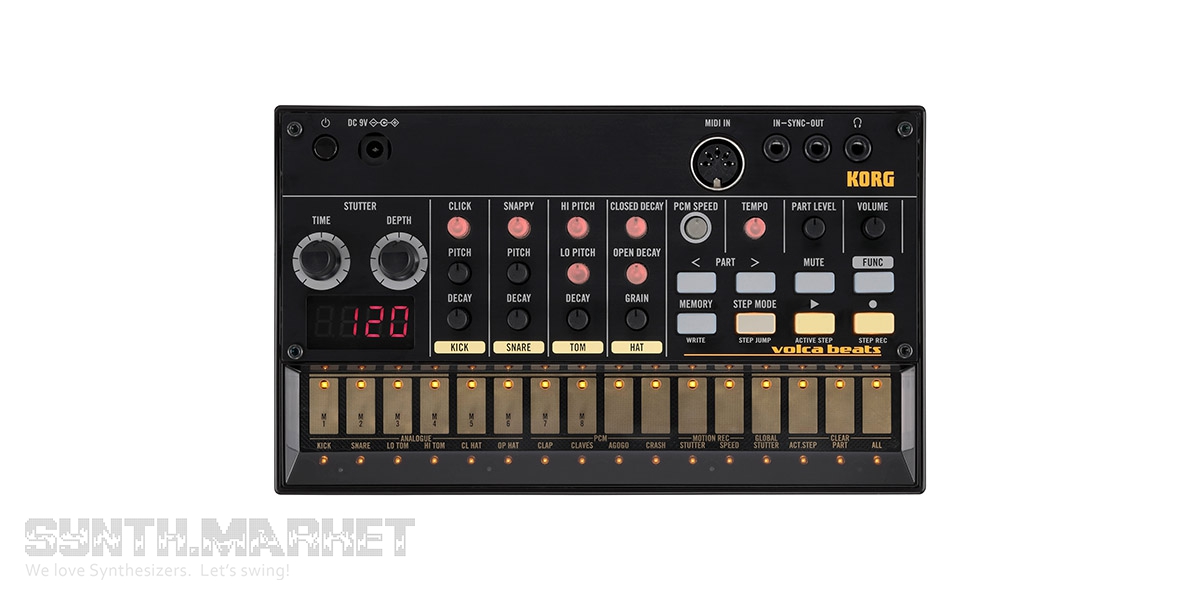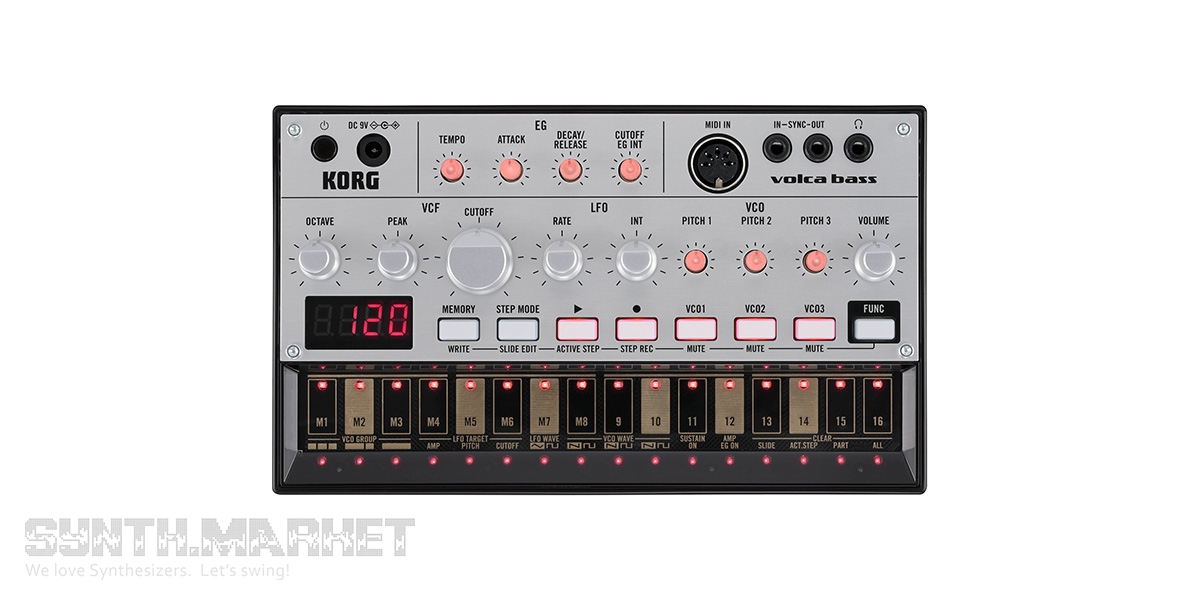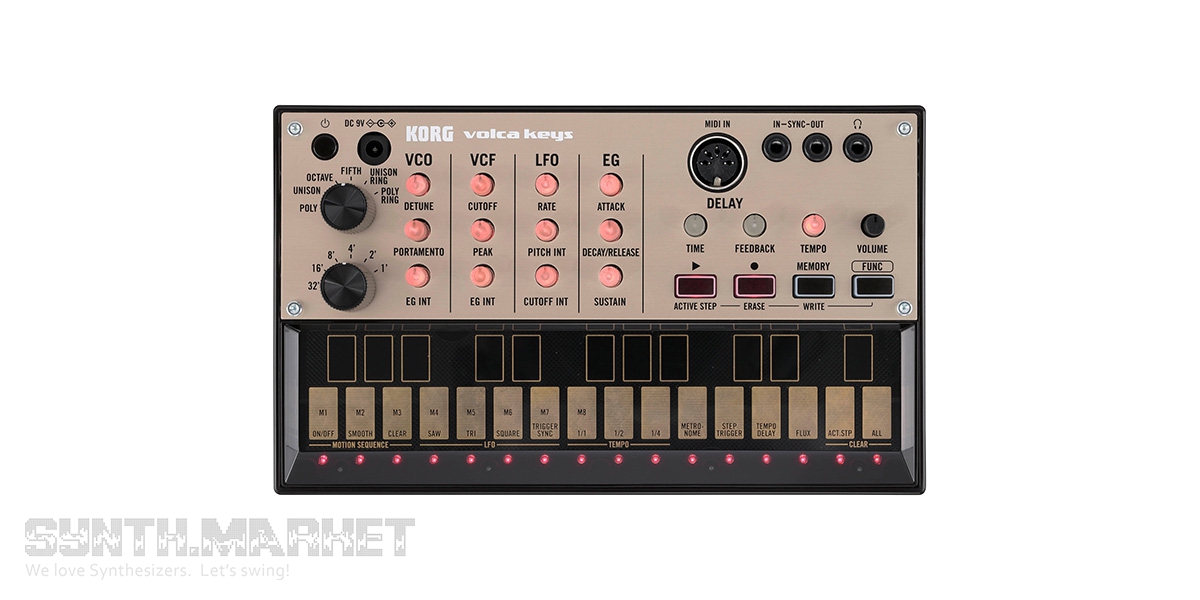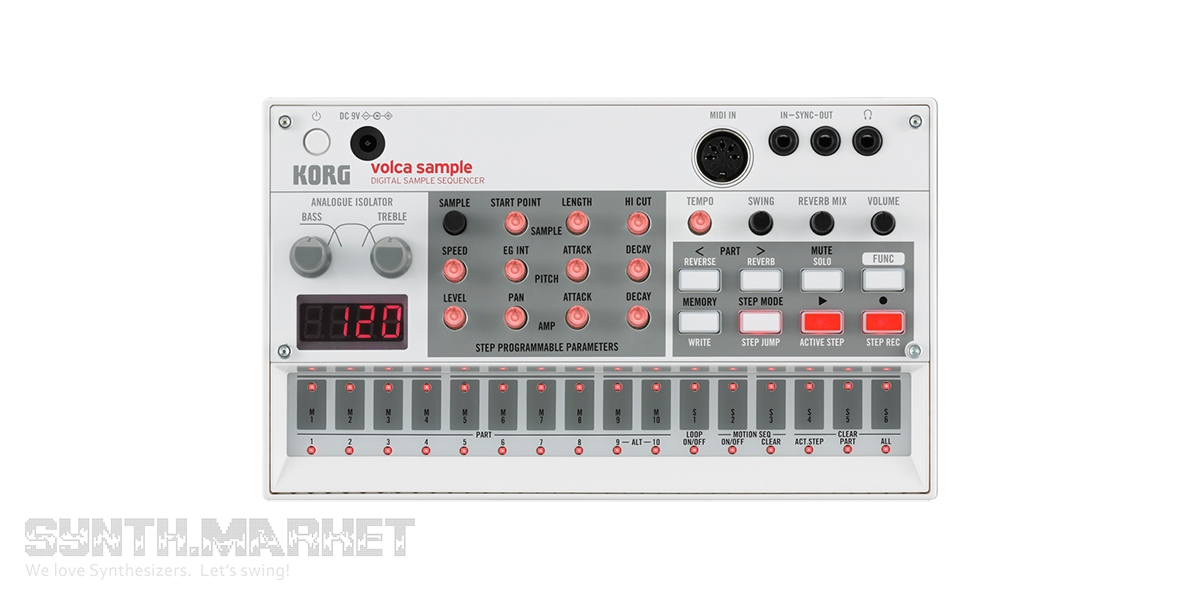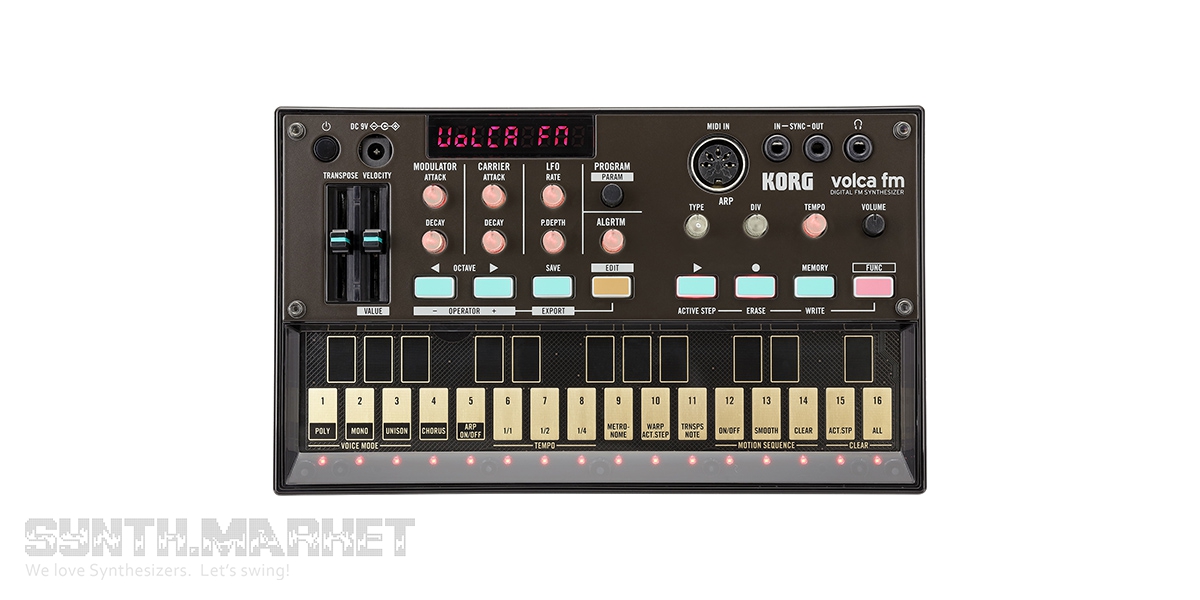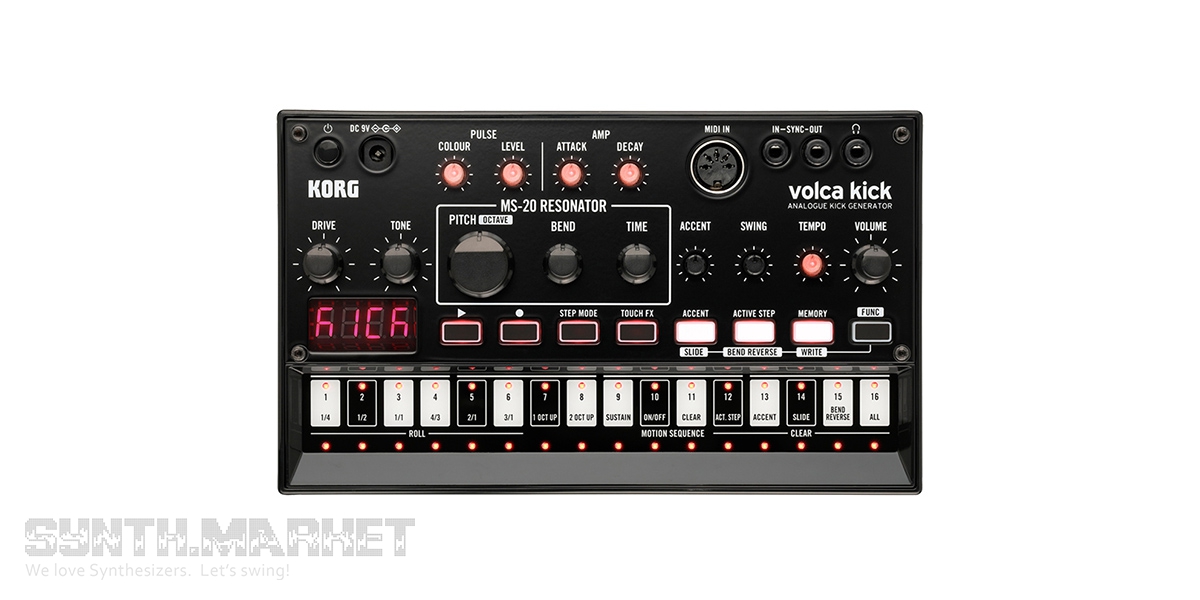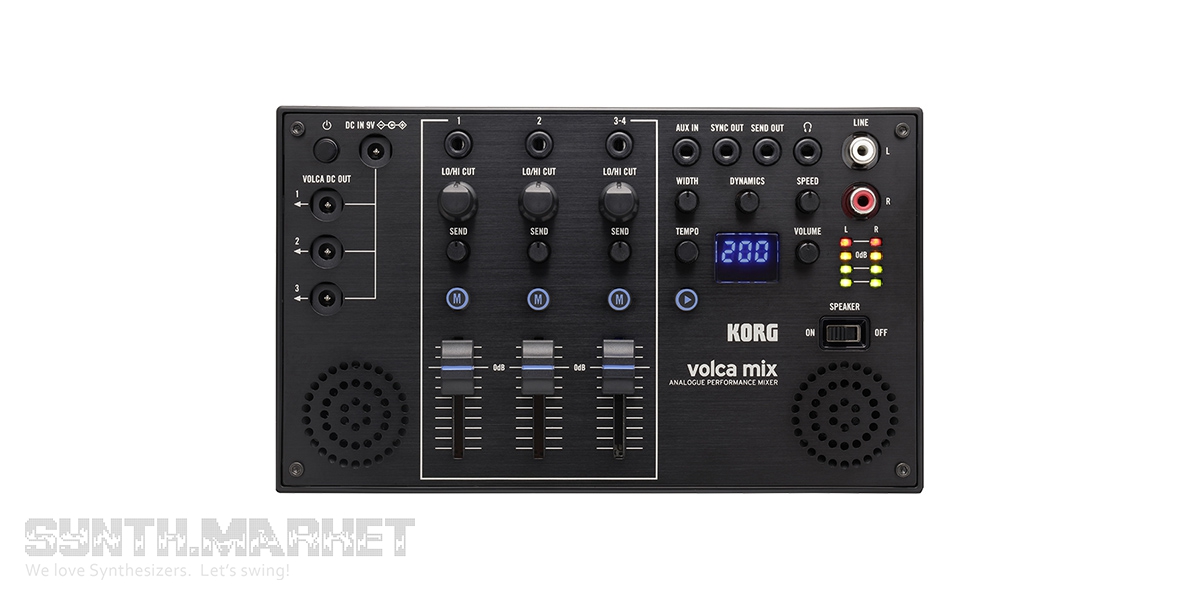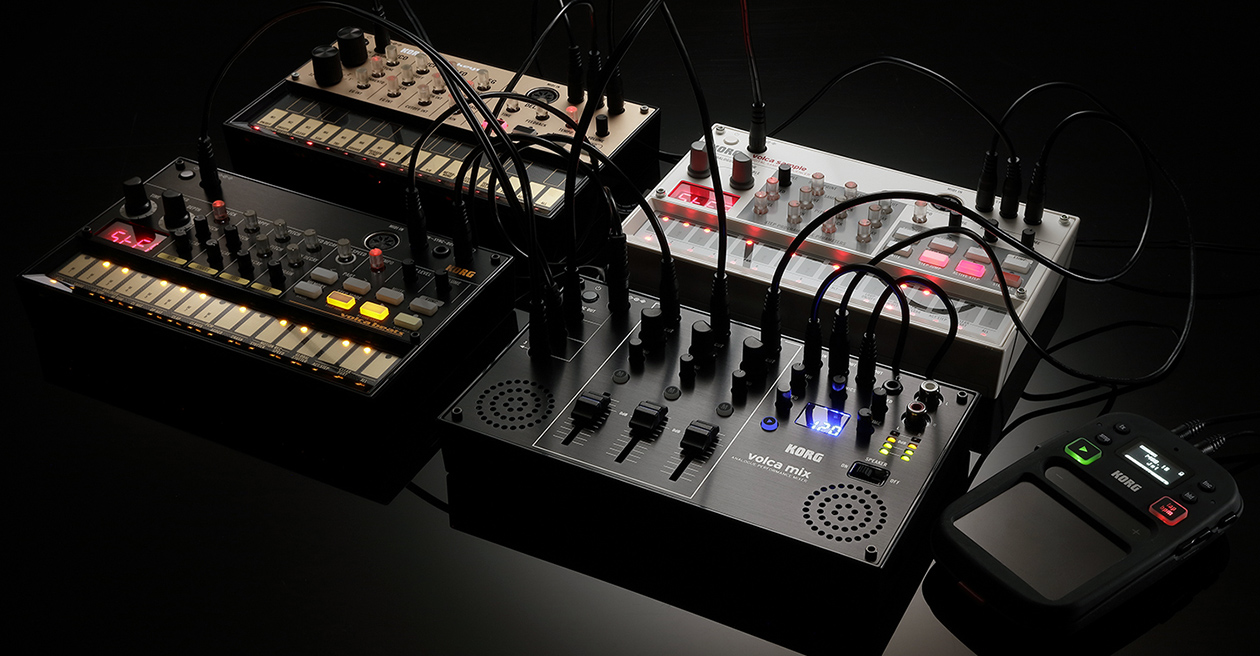
The line of volca devices from KORG, a legendary japanese company, is probably the most balanced and functional in the segment of portable and inexpensive (up to $200) music creation tools. These are truly original products, combining the best ideas of synthesis and sampling of the last century with a convenient, intuitive design and nice sound (for their price).
All representatives of the volca family have a single form factor - a plastic box with a metal front panel with knobs and buttons and a touch panel. The size of the box is 193x115x45mm, and the weight does not exceed 400 grams. Each instrument is equipped with a MIDI input, a linear output and a small built-in speaker, as well as an input and an output for synchronization with other volcas. All devices are powered by 6 AA batteries or with a 9V power supply, which is optional.
And now let's consider all the devices in more detail, starting with volca beats. This is an analog drum machine with a 16-step sequencer used in the Electribe grooveboxes. It has 6 analog and 4 PCM channels on board, for playing the most wanted percussion sounds. To control the analog voice, there are 4 sections (kick, snare, tom, hat), with three handles each. So, you can control the pitch and attenuation of the signal, and for kick and snare, you can use the Click and Snappy knobs to help emphasize the attack. As for PCM, then you can only change the playback speed. It would seem that there are not so many controls, but despite this volca Beats produces a very diverse and juicy timbre in the spirit of TR-707 and TR-808, which sound very relevant in the modern context. The sequencer in this drum machine is extremely simple and convenient, as for, in fact, in all volcas. It allows you to record and edit patterns on the fly using 16 buttons on the front panel, and still save your patterns (up to 8). There is also a Stutter section designed to create the effect of a fraction or a delay by retriggering one or another step. In general, this is a very interesting device, generating a very decent functionality and a good sound for its price.
volca bass is an analog bass synthesizer with three oscillators and a sequencer from Electribe. Oscillators can work both in unison and independently, generating different sequences, which allows you to create quite complex parts. Waveforms: a saw and a square, the most spectrally saturated of the standard ones. The pitch is adjusted separately for each oscillator. The device also has a standard low-pass filter (12dB/ oct.), a low frequency oscillator (LFO) with three waveforms and an envelope generator. All this is enough to build massive bass timbres. The sequencer here is the same as in the KORG volca beats, but with a Slide function that creates a more integrated sound of both the individual steps and the entire sequence.
volca keys is an analog synthesizer, quite powerful despite its size, which is great for creating leading parts. It contains three oscillators operating in 6 modes (three-voice polyphony, unison, octave, fifth, unison ring and poly ring), a three-wave LFO, an ADSR envelope generator sharing the same decay/ release control, a voltage controlled low-pass filter derived from the legendary miniKORG 700s, a loop sequencer and the digital delay, slightly dirty, but nice sounding. The interface of this instrument contains 27 sensor buttons, which are surprisingly convenient to play, despite the first sight. There is also an octave switch. As for the sequencer, it is slightly different from the previous devices, because it is not step sequencer, but a loop-sequencer, which is perhaps more suitable for the leading parts, in addition, it is equipped with a metronome. A very good tool for people discovering the subtractive synthesis.
Unlike the first three instruments, which are mostly analog, the volca sample is almost completely a digital device. This is a sampler, made in the style of the 90's, and, from the point of view of both external and internal design. So, the maximum memory occupied by samples is 4MB, and the maximum number of samples is 100, which can sometimes limit the possibilities. Samples can be loaded and re-recorded from any device, the maximum length is 65 seconds. On board there is a fairly large section for managing samples, in particular to manipulate their length and height, for height and the amplifier there are envelope generators, and there is also the possibility of panning. The only analog part of the sampler - Isolator - allows you to cut or add (up to 6dB) low or high frequencies. This can help a lot during live performances. The sequencer in the device is 16-step, with the ability to record live parameters changes for 12 control knobs. About the effects, there's only a reverb, however, it is very good and perfectly diffuses the audio signal. Also the device has a new knob called Swing which is absent in all other volcas.
In general, the volca sample leaves a very good impression of itself, it's very easy and fun to create music with it, the controls are so intuitive that even after a 15-minute acquaintance, you can do something interesting.
volca fm is another digital device in the volca lineup. This time the familiar box contains a 3-voice FM synthesizer. It has 6 operators and 32 algorithms for their connection. In general, in terms of capabilities, it almost completely repeats the widely-known DX-7, you can even play patches from it, but the iconic Yamaha synthesizer has, of course, bigger functionality and more voices. Operator parameters can be controlled using a special menu, however, it is difficult to call it simple and convenient, even taking into account the sheet attached to the synthesizer with explanation of parameters and 32 connection schemes of FM operators. However, if you already understand frequency modulation, then it's quite easy to start creating your own patch and enjoy the possibilities of this type of synthesis. This device has also faders for transpose and velocity control, as well as a 16-step sequencer with the ability to record parameters changes, already familiar from the previous devices of the volca line. In general, volca fm is a very interesting tool, but not very suitable for those who are not familiar with FM synthesis.
volca kick is an analog kick generator, as stated on the manufacturer's website, but in fact the instrument is suitable not only for creating a fat kick, but for many other things. This is an analog synthesizer based on a resonating filter from the legendary KORG MS-20. It has an envelope generator, an overdrive, Pulse section, with which you can add and adjust attack transients, and, in fact, the filter itself, responsible for the power and fat content of this synthesizer. The drum's timbre in the device is decomposed into three parts, each of which can be adjusted separately. As for the sequencer, there are 16 steps in it and, in addition to the functions already known by previous models, there are effects that can be added simply by clicking on the corresponding keys on the interface to diversify the patterns.
The last device that is emerged inside the volca series is the volca mix. This is an analog mixer designed for performances and it is an extremely convenient and long-awaited addition to the existing volca instruments. It has everything you need for a setup of three volcas: 9V power output, and a mixer channel for each one. The mixer has 4 channels, two of which are mono, and one is stereo. Each channel has a single-knob equalizer of high and low frequencies, like we see in the volca sample, the send, the volume control and the channel on/off button. The volca mix can send a synchronization signal to all other devices and start playing patterns at all at once. On board the mixer there is a compressor that can work in the side-chain mode and a volumeter that measures the level of the output signal.
In general, all instruments of KORG volca family are perfectly thought-out devices, each of which is good in itself, and in combination with other devices. Yes, of course, they probably are not very good for the pro-level sound design because of limited functionality, but they meet all the basic requirements of musicians: they are compact, reliable, simple and understandable, have a nice price, and most importantly, you can extract very interesting sounds from them.


